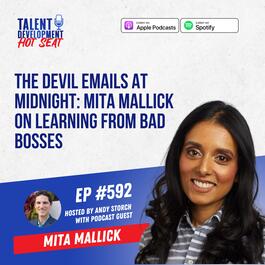
The Devil Emails at Midnight: Mita Mallick on Learning from Bad Bosses
In this candid and insightful conversation, host Andy Storch welcomes back Mita Mallick to explore what effective leaders can learn from the worst bosses they've encountered. Drawing from her new book, The Devil Emails at Midnight: What Good Leaders Can Learn from Bad Bosses, Mita shares her personal journey, the archetypes of bad bosses, and practical strategies for both surviving toxic leadership and breaking negative cycles as a leader. Subscribe to our weekly updates and monthly talent development newsletter here. Order Own Your Brand, Own Your Career on Amazon Apply to Join us in the Talent Development Think Tank Community! This episode is sponsored by LearnIt, which is offering a FREE trial of their TeamPass membership for you and up to 20 team members of your team. Check it out here. This episode is also sponsored by Mento which offers a unique 80/20 mix of coaching and mentorship so that your people can increase performance and success. Connect with Andy here: Website | LinkedIn Connect with Mita: LinkedIn: Mita MallickTop 5 Key Notes: 1.Bad Bosses Aren’t Born, They’re Made Mita emphasizes that most bad bosses don't set out to be that way—often they're shaped by their own experiences, circumstances, or lack of self-awareness. Many toxic behaviors are responses to external or personal stress, not innate malice. 2.Recognizing Archetypes of Bad Leadership Mita's book introduces 13 archetypes of bad bosses, including Medusa (the bully), the Chopper (micromanager), the Napper (disengaged boss), and Tony Soprano (talent hoarder). These archetypes help us recognize and address negative behaviors in leadership. 3.Impact of Exclusion and Toxic Workplaces Drawing from her personal journey, Mita highlights the profound impact that exclusion and toxic bosses can have on employee wellbeing, engagement, and confidence. Her own experiences with bullies followed her from childhood schoolyards into the workplace, fueling her passion for building inclusive cultures. 4.Advice for Employees Facing Toxic Leadership Mita suggests practical steps for employees: document toxic behavior, develop an exit strategy (even if it’s internal), network discreetly, and focus on activities outside work that rebuild confidence. She stresses that individuals alone cannot fix toxic workplaces or change others’ behavior—they have to prioritize their own well-being. 5.Role of HR and Talent Professionals in Addressing Toxicity The conversation offers guidance for HR and talent leaders: document issues, influence decision-makers with facts, and recognize when to recommend coaching—or, when necessary, help leaders move on. Using curiosity, vulnerability, and honest feedback can guide leaders toward positive change, but some situations may require more decisive...
From "The Talent Development Hot Seat podcast - The Top podcast for L&D Professionals"


Comments
Add comment Feedback